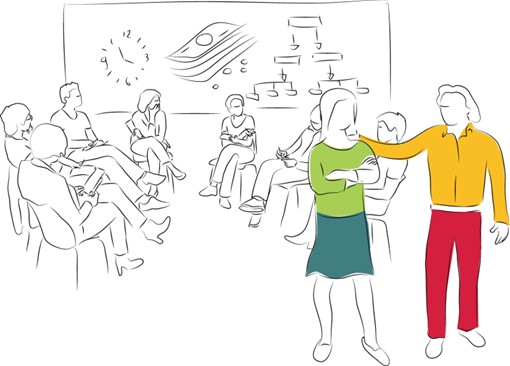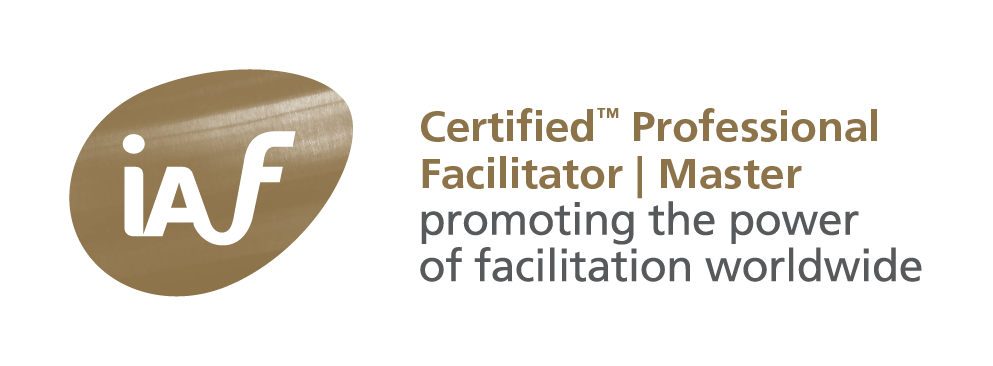
Even facilitators have a hard time in defining what facilitation really is. What do we do? Is it an art, a trick, an attitude? Do we manipulate or charm a group towards results? Is there something special and unique, or is it something everybody does, just without consciously knowing? And what makes it so difficult to answer this question?
Question of leadership
To start with the latter question: facilitation itself is about emerging meaning. When we meet in a meeting, we immediately start making meaning of our situation. Where are we? What’s happening to us? Who are we? What shall we do next? How to allocate resources to actions? This is so common, we don’t need a facilitator. Or rather, we create a facilitator, usually called “leader”. I’ll come back to the connection between leadership and facilitator later. Bion[1] describes these processes. He noticed that part of what a working group does, is looking for or making a leader. Someone becoming a kind of facilitator. And this creates its own problems too.
As the presenting situation becomes too complex, we are on unknown territory. Then leadership may become part of the problem, as Bion also showed in his research. Who do you call? As Laura sketched in the previous chapter: you need a guide, calling in an external facilitator. And then, the facilitator, becoming part of the meeting, needs to make meaning too. A facilitator needs to define his or her role. Are you in need of an expert for advice? An artist for creativity? A trainer, coach? Do you need a leader, chairperson, a communicator or listener? Part of facilitation is defining the role of facilitation itself.
Definitions on offer
In the Glossary see page 133 – 143 we provide several definitions of facilitation:
- Processes or skills by which a (independent outside) party supports meeting(s) of participants to move toward improvement or resolution of a problem. Usually more than two parties are involved.
- Facilitation can operate at many levels, from providing meeting space to active intervention as a mediator, moderator, chair, coach, counselor, MC (Master of Ceremonies), manager, teacher, or trainer.
- Supporting parties to set ground rules and designing agendas for meetings, promoting better communication between parties, and analysis of the situation and possible outcomes—in general, helping the participants keep on track and working toward their mutual goals. It may also mean helping them set those goals.
- It is procedural assistance provided to enable participants to communicate more effectively and move towards agreement.
The IAF, International Association of Facilitators, uses an even longer definition:
- Group facilitation is a process in which a person whose selection is acceptable to all the members of the group, who is substantively neutral, and who has no substantive decision–making authority diagnoses and intervenes to help a group improve how it identifies and solves problems and makes decisions, to increase the group’s effectiveness.
As you may notice: it sounds like leadership, a special kind of leadership.
The making of an easy word: relationship
Facilitation is usually thought of as “making easy”, as in the French “facile”. That is what facilities do: an easy room, equipment, coffee and tea. The word facilitate itself consists of two parts: “facere” and “li”. The Latin word facere, means to make and is recognizable in factory, fact and fiction. The ancient “li” means something like link, connecting. We recognize it in “liaison”, “intelligence”, “reality”, and even in “line”. A line connects, for example a telephone line. It is somewhat harder to recognize in “relationship” and “leadership”.
The word relationship also means making (“ship”, to shape) connection (la = li). And a leader through leadership also connects. Leader and ladder share the same source, lea. Like a ladder, a leader gives support to move up. Relationships are often considered to exist inside a group, while leadership is more often associated with relations between groups and a group and its outside world. The words are interconnected. Sometimes we speak of facilitative leadership.
Uneasy: pattern breaking skills
“A facilitator relies firstly on a set of skills,” Thijs Homan, Professor Change and Implementation at the Open University Netherlands, writes in the introduction of the Dutch version of this book[2]. He or she is able to contract a client, analyze a given situation, design scenarios for a meeting and pilot the group through the process. More often than not, he or she needs to guide when the going gets hard. At the end, at the destination, participants have to take up actions.
The skills are analytical (see De Wit), assertive as well as influential and participative (see Farrell) or provocative (see Schanssema). Moreover, sometimes a facilitator needs to be inventive or to evoke new symbols and ideas from a group (see Mostert). This is being explained in more detail in the following chapter “Relationships within Facilitation”.
In a meeting or session a facilitator is often an outside party, considered “neutral”. The neutrality is towards the content. (S)he has no stake in any specific outcome. With respect to relationships, though, a facilitator remains autonomous. Sometimes (s)he supports the group, and then again opposes them; even a client needs opposition sometimes. As Vrancken calls it in her contribution: the free play of forces.
And (s)he does more, not just in the actual meeting. “The biggest challenge,” Professor Homan stipulates: “is changing the power structure of the situation.” “The real cause of any problem needing a facilitator,” he continues: “is a standoff between interacting global patterns in organizations. Progress often implies changing existing patterns. A facilitator is a pattern breaker, on the front stage – during the session –, as well as at the back stage – during the design of the session and the debrief.” This he calls, “a complex responsive process approach.” A facilitator also needs inventive skills and an ability to “break the rules, without breaking the relationships”. That is why we have designed the format of the 24 contributions in this way: client response, situation before, during and after the meeting and reflection by facilitator.
Results of facilitation
Many of the definitions contain “to move towards results”. We asked this question to Professor Homan: “What is the result of facilitation?”. He answered: “When somebody facilitates, he or she doesn’t produce input aimed at a preconceived result. That’s more the work of a capable chairperson. The results of a facilitated process is something emergent, something created through the interactions within the group, including the facilitator. At the end of the road, you hope the client and the group will unanimously say, ‘we’ve been facilitated.’”
He continues: “If you want to know and pinpoint the results of a facilitated process before hand, you’re doing something awkward: you’re supplying something upfront, which you must have as a result in the end.” So, when results are given upfront, it is not facilitation. The results, in other words, are part of the facilitation process too. There will be results, as every contribution tells you, but always with unexpected components.
Meaning of facilitation
Meaning, in my view, is an emergent property of interactions. Meaning is being created all the time. Meaning is being communicated. In communicating, we transfer a content (“message”) and a relationship (“process”) between parties. The relationship between the parties is necessary to understand the meaning of the content. The relation classifies the content, as Paul Watzlawick[3] calls it. The meaning of “bring me a cup of tea” depends on who is asking who. It can be a patient to a nurse, or a child to its parent. It might be your boss asking you, or yourself sitting at a small table in a cafe in London. The meaning might be: “I need taking care”, or “I’m glad I’m home and need a talk.” It might be an interview or the dreaded one-on-one with your superior. Or you’re just thirsty after a long walk.
This raises another question. If it is not in the content, how is meaning and its relationship being communicated? The way the meaning of message is conveyed, is by tone of voice, gesture, attitude, accentuation, stresses, “spaces”, rests. This is called “punctuation”. It is about CAPITAL,,,, (comma’s) … (points) and ??! It is being called “la tone qui faites la musique”, if you pardon my French. One examples will suffice:
The project manager says: “The client is not committed.”
“The project manager”, says the client, “is not committed.”
The same sentence, the same message, but completely different meaning, just by adding two comma’s and replacing the quotes. You can also imagine our problems in translating the experiences in this book. Meaning not only gets lost in translations but also through punctuation, even when we speak the same language.
Meaning, we don’t often realize this, is also a pattern, a habit, something we’ve got used to. We usually do not question the words we use. In some cases, the pattern and therefore the meaning of the words, has to change. The contribution by Morèn, is a clear example. She noticed that for some management team members “team work” means “a biweekly meeting”, while the same word for others means ”working together on a common purpose”. She dared to ask a question to break the pattern. She then notices, that the relationships changed, but the words remained the same.
Communicating meaning
The word communicating comes from communicare “to share, divide out; impart, inform; join, unite, participate in”, literally “to make common”. Common comes from Proto-Indo-European *ko– “together” + *moi–n-, “change, exchange”. To change together. Suddenly you realize, why communion, breaking bread, sharing wine, is called communion.
In order to make sense of the situation, we have to make sense of our situation first. This sounds as awkward as it feels. Because we’re in unknown territory, our usual maps won’t work. It is the strange feeling you might have, when entering a meeting room. The meeting has to acknowledge being lost, needing a guide. And this we find difficult, as we’ve been trained in always knowing who we are, where we are and where to go. We have firstly to relate to reality, or even, go back to reality. Then envision our intentions, intended results, our desired state. Here a facilitator, as a guide and pilot, supports the meeting. She or he intervenes, facilitates. And after that, releases you again.
[1] W.R. Bion, Experiences in Groups: and other articles, 1968, ISBN-13: 978-0415040204
[2] Jan Lelie, Henri Haarmans e.a., “Faciliteren zonder omwegen”, 2013,ISBN 978-90-78440-65-9
[3] Paul Watzlawick, Janet Helmick Beavin, Don D. Jackson, Pragmatics of Human Communication, 1967




